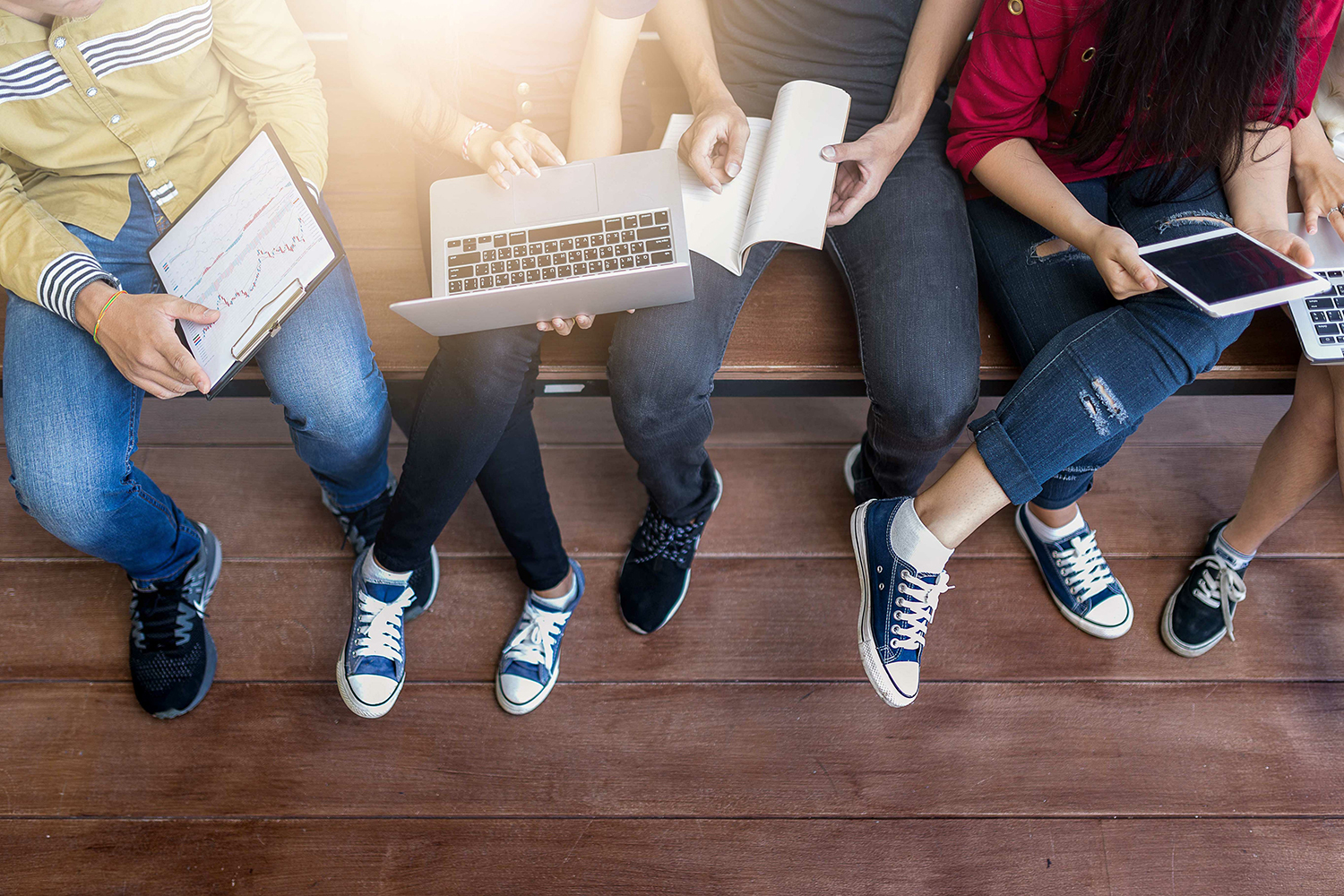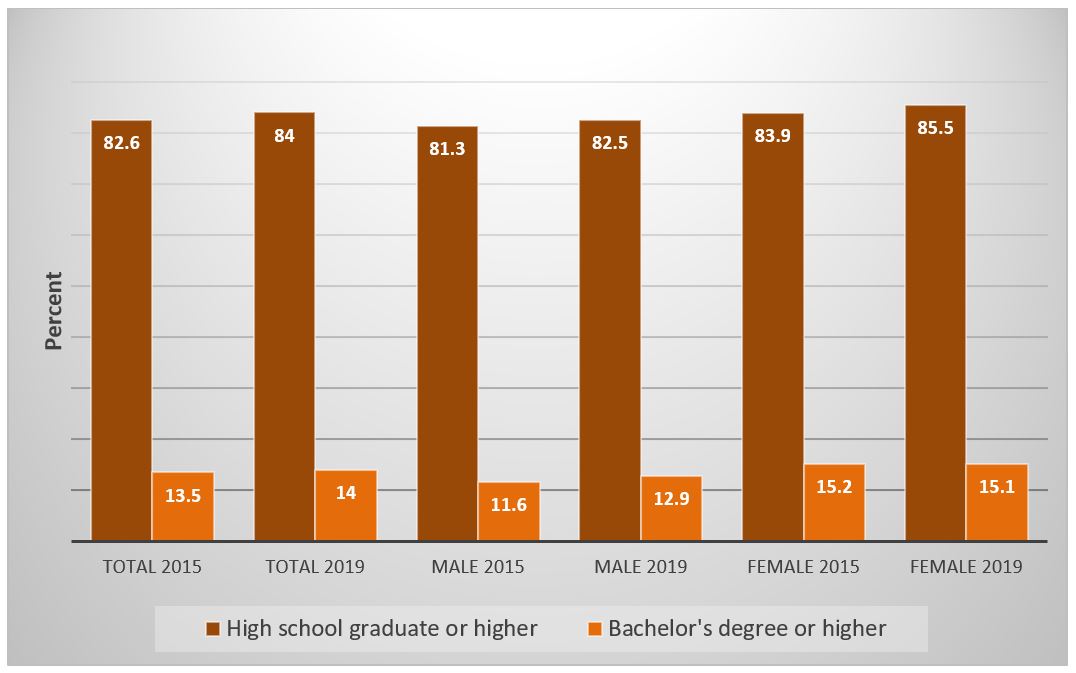
November 2021 is American Indian and Alaska Native Heritage Month. This article presents statistics for American Indian and Alaska Native educational attainment showing an improvement across the attainment levels.
Educational attainment refers to the highest level of completed education. Between 2015 and 2019, educational attainment rates among American Indians and Alaska Natives in the North Central Region (NCR) slightly increased in both monitored categories – high school graduate or higher and bachelor’s degree or higher. During this period, the percentage of those who had completed at least high school increased from 82.6% to 84% (Figure 1). For comparison, in the U.S., the percentage of American Indians and Alaska Natives with high school or higher education increased even more – from 79.1% to 87.2%.
Figure 1. Educational attainment of American Indians and Alaska Natives in Midwest by gender in 2015 and 2019 (in %)

Source: U.S. Census Bureau: American Community Survey, ACS 1-Year Estimates, Subject Tables ACSST1Y2015 and ACSST1Y2019
The percentage of American Indians and Alaska Natives in the NCR with a bachelor’s or higher degree increased by 0.5% in total between 2015 and 2019, driven mainly by a higher percentage of men that earned a bachelor’s or higher degree. On the national level, the rate of American Indians and Alaska Natives with a bachelor’s or higher degree grew from 14.1% in 2015 to 16.1% in 2019. Unlike in the Midwest, shares of people with a bachelor’s or higher degree increased for both females (from 15.3% to 17.5%) and males (from 12.8% to 14.1%). Nevertheless, the educational attainment rates were higher for females than for males.[1]
The positive trend in education of American Indians and Alaska Natives corresponds with an increase in educational attainment rates of the general population on a national level. In 2019, the percentage of those who had completed at least high school was higher for American Indians and Alaska Native population (87.2%) than for a general population in the U.S. (87.1%) and lower than for a general population in Midwest (89.9%). However, the rate of those who had completed a bachelor’s degree or higher differed significantly. The rate was lower for American Indians and Alaska Native populations (16.1%) than for a general population in the U.S. (30.6%) and Midwest (29.1%). Significant differences were between educational rates of American Indians and Alaska Natives and the general population with a bachelor’s degree or higher.
A closer look at the state level of the Midwest Region reveals significant differences in the educational attainment in total and as well as between men and women (Figure 2). In 2019, the percentage of those who had completed at least high school was highest in Wisconsin (90.8%), Missouri (88.3%), and Michigan (87.6%). Conversely, the lowest level can be seen in Illinois (74%), Ohio (79.2%), and South Dakota (80%). While the share of high school graduates or higher in Illinois is the lowest among the NCR states, the percentage of the population with completed a bachelor’s degree or higher is the highest in the NCR (23.6%). Ohio, with 17.7%, takes second place and North Dakota (17.6%) is third. Far behind these states is Iowa, with
8.3% of the population that completed a bachelor’s degree or higher, and South Dakota, with the rate of 8.8%.
Figure 2. Educational attainment of American Indians and Alaska Natives in the U.S. and Midwest by gender in 2019 (in %)

Source: U.S. Census Bureau: American Community Survey, ACS 1-Year Estimates, Subject Table ACSST1Y2019
Female educational attainment outpaces males on the national, regional, and state levels. Figure 2 also shows that women make up a smaller share of high school dropouts than men. The percentage of women who graduated from a high school or higher was greater in nine states of the NCR, and the share of women with a bachelor’s degree or higher prevailed in seven out of 12 Midwestern states. The attainment rates for females and males were not significantly different in some states like Illinois, Michigan, Minnesota, and South Dakota. However, a substantial difference between males and females with bachelor’s degree or higher appeared in North Dakota (23.7% of women versus 8.9% of men), Ohio (23.4% of women versus 13.3% of men), Nebraska (14.6% of women versus 5.7% of men), and Wisconsin (18.8% of women versus 10% of men).
[1] U.S. Census Bureau: American Community Survey, Educational Attainment
Author: Zuzana Bednarikova, zbednari@purdue.edu
Dr. Zuzana Bednarikova is a Research and Extension Specialist at NCRCRD.
